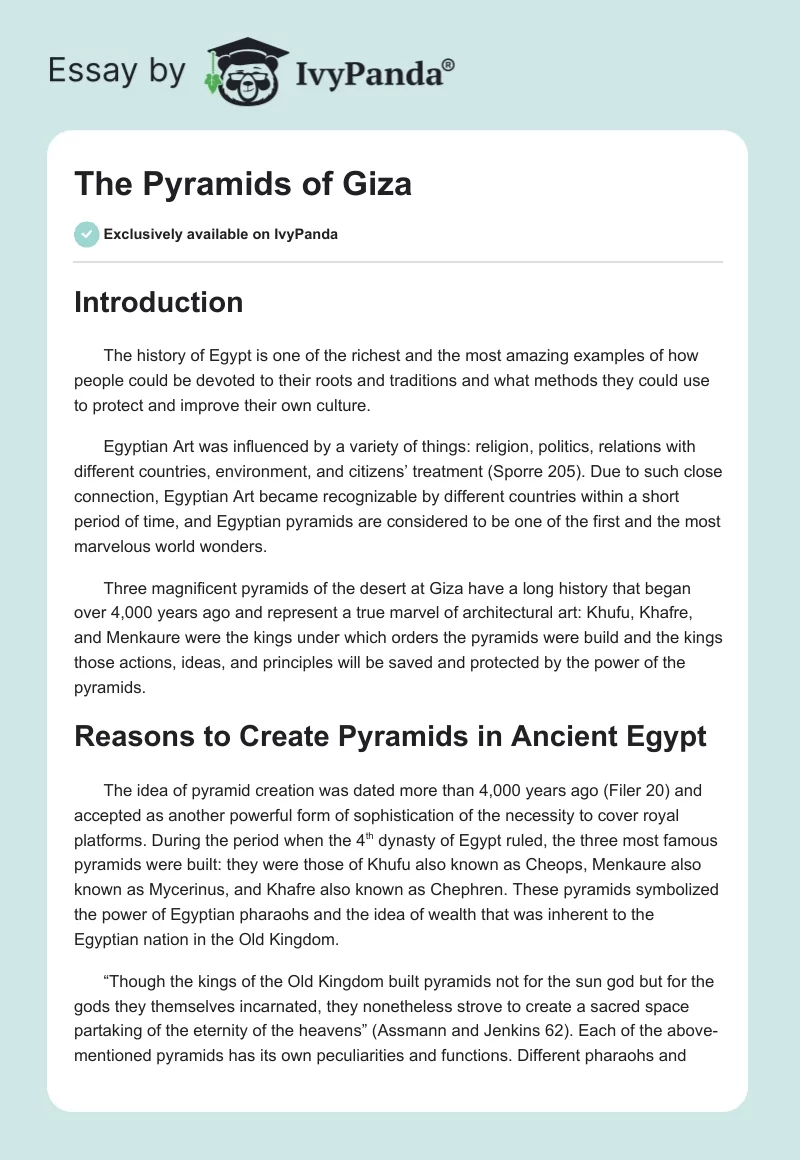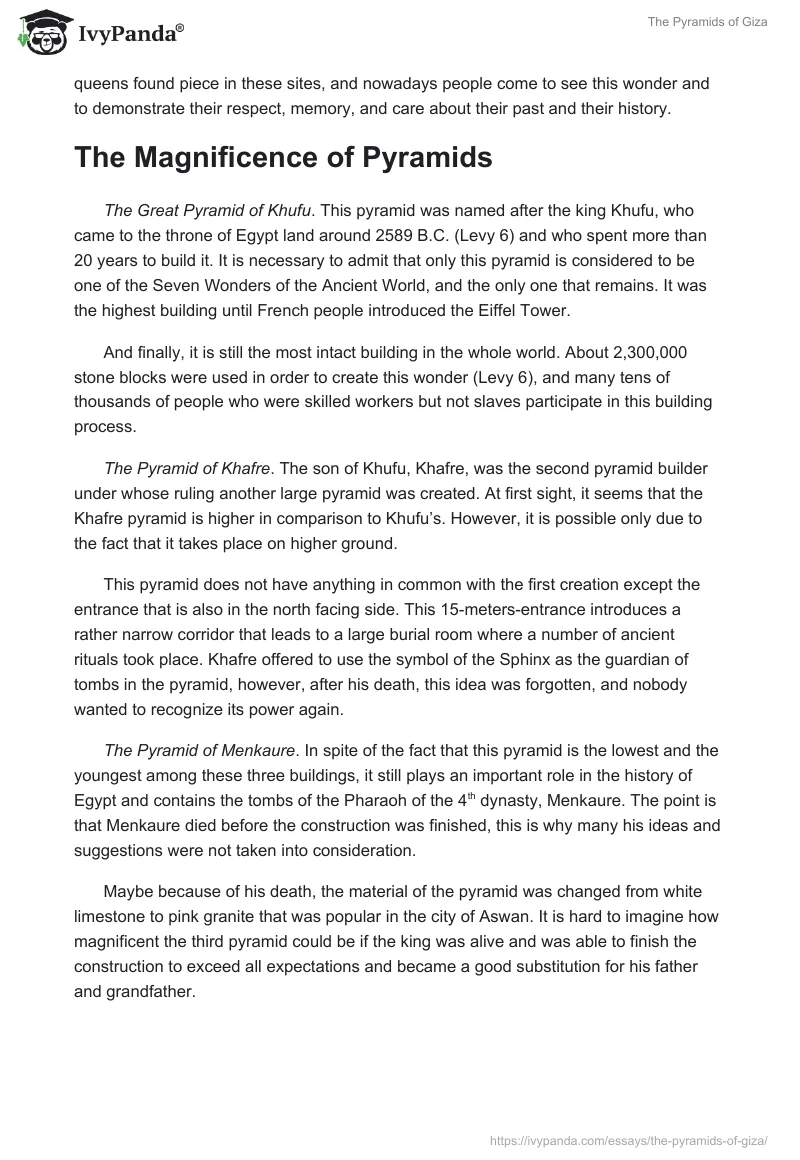Introduction
The history of Egypt is one of the richest and the most amazing examples of how people could be devoted to their roots and traditions and what methods they could use to protect and improve their own culture.
Egyptian Art was influenced by a variety of things: religion, politics, relations with different countries, environment, and citizens’ treatment (Sporre 205). Due to such close connection, Egyptian Art became recognizable by different countries within a short period of time, and Egyptian pyramids are considered to be one of the first and the most marvelous world wonders.
Three magnificent pyramids of the desert at Giza have a long history that began over 4,000 years ago and represent a true marvel of architectural art: Khufu, Khafre, and Menkaure were the kings under which orders the pyramids were build and the kings those actions, ideas, and principles will be saved and protected by the power of the pyramids.
Reasons to Create Pyramids in Ancient Egypt
The idea of pyramid creation was dated more than 4,000 years ago (Filer 20) and accepted as another powerful form of sophistication of the necessity to cover royal platforms. During the period when the 4th dynasty of Egypt ruled, the three most famous pyramids were built: they were those of Khufu also known as Cheops, Menkaure also known as Mycerinus, and Khafre also known as Chephren. These pyramids symbolized the power of Egyptian pharaohs and the idea of wealth that was inherent to the Egyptian nation in the Old Kingdom.
“Though the kings of the Old Kingdom built pyramids not for the sun god but for the gods they themselves incarnated, they nonetheless strove to create a sacred space partaking of the eternity of the heavens” (Assmann and Jenkins 62). Each of the above-mentioned pyramids has its own peculiarities and functions. Different pharaohs and queens found piece in these sites, and nowadays people come to see this wonder and to demonstrate their respect, memory, and care about their past and their history.
The Magnificence of Pyramids
The Great Pyramid of Khufu. This pyramid was named after the king Khufu, who came to the throne of Egypt land around 2589 B.C. (Levy 6) and who spent more than 20 years to build it. It is necessary to admit that only this pyramid is considered to be one of the Seven Wonders of the Ancient World, and the only one that remains. It was the highest building until French people introduced the Eiffel Tower.
And finally, it is still the most intact building in the whole world. About 2,300,000 stone blocks were used in order to create this wonder (Levy 6), and many tens of thousands of people who were skilled workers but not slaves participate in this building process.
The Pyramid of Khafre. The son of Khufu, Khafre, was the second pyramid builder under whose ruling another large pyramid was created. At first sight, it seems that the Khafre pyramid is higher in comparison to Khufu’s. However, it is possible only due to the fact that it takes place on higher ground.
This pyramid does not have anything in common with the first creation except the entrance that is also in the north facing side. This 15-meters-entrance introduces a rather narrow corridor that leads to a large burial room where a number of ancient rituals took place. Khafre offered to use the symbol of the Sphinx as the guardian of tombs in the pyramid, however, after his death, this idea was forgotten, and nobody wanted to recognize its power again.
The Pyramid of Menkaure. In spite of the fact that this pyramid is the lowest and the youngest among these three buildings, it still plays an important role in the history of Egypt and contains the tombs of the Pharaoh of the 4th dynasty, Menkaure. The point is that Menkaure died before the construction was finished, this is why many his ideas and suggestions were not taken into consideration.
Maybe because of his death, the material of the pyramid was changed from white limestone to pink granite that was popular in the city of Aswan. It is hard to imagine how magnificent the third pyramid could be if the king was alive and was able to finish the construction to exceed all expectations and became a good substitution for his father and grandfather.
Conclusion
The role of pyramids in Egypt is significant indeed. Each king made numerous attempts to demonstrate his power and wealth by means of pyramids and other buildings. The pharaohs like Khufu, Menkaure, and Khafre, who came from the 4th dynasty, left probably the most significant and amazing heritage that is now recognizable by the whole world.
The three pyramids of Giza attract the attention of people because of different purposes: to grasp the idea of Egyptian culture, to learn deeper the architecture of ancient buildings, to understand the essence of traditions and the significance of pharaohs’ lives, etc. The evaluation of these three pyramids helps to realize the Egyptian Art is one of the most delicate and amazing arts in the whole world that cannot be duplicated under any conditions.
Works Cited
Assmann, Jan, and Andrew Jenkins. The Mind of Egypt: History and Meaning in the Time of the Pharaohs. Cambridge, Mass.: Harvard UP, 2003. Print.
Filer, Joyce. Pyramids. New York: Oxford University Press, 2006. Print.
Levy, Janey. The Great Pyramid of Giza: Measuring Length, Area, Volume, and Angles. New York: Rosen Pub. Group, 2006. Print.
Sporre, Dennis, J. Reality through the Arts. 7th ed. Upper Saddle River, NJ: Prentice Hall, 2009. Print.


